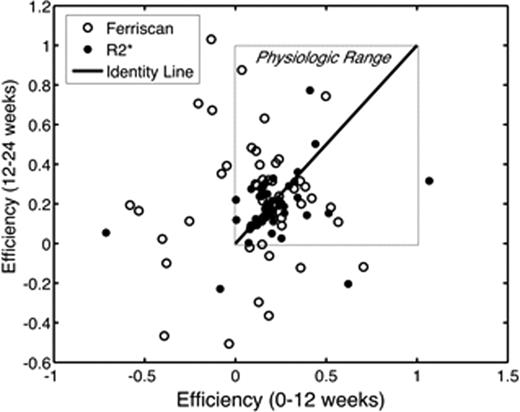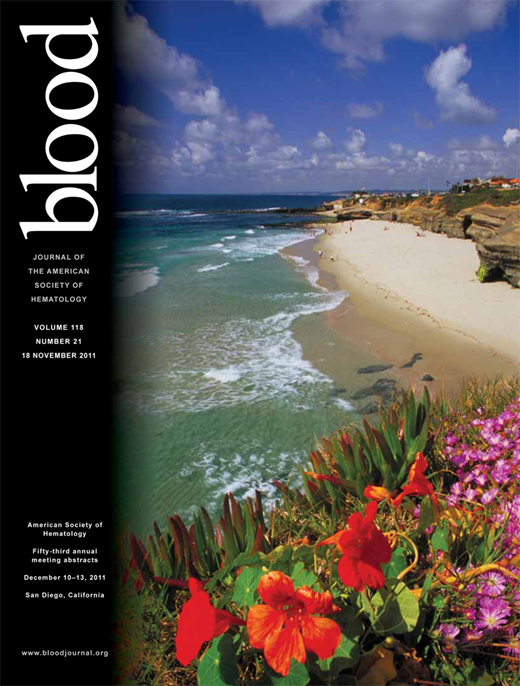Abstract
Abstract 5296
MRI assessment of LIC concentration is increasing utilized as the primary outcome variable of clinical trials for iron chelation. The MRI parameters R2 and R2* can both be used for this purpose but have slightly different sensitivities to the scale and distribution of tissue iron deposits. As a result, these techniques may provide significantly disparate results in any given patient and may diverge following abrupt changes in chelation therapy. It is not practical, nor ethical, to use liver biopsy to validate R2 and R2* LIC measures on a short time scale. Thus, we used calculations of chelator molar efficiency to determine whether predicted changes in LIC were consistent with the known iron balance assessed by transfusional burden and drug consumption.
The Phase II trial of FBS701, a novel oral iron chelator, measured LIC by both R2 and R2* at screening, 12 weeks, and 24 weeks of therapy; nine thalassemia centers participated in 7 countries. 51 individuals completed 24 weeks of treatment. Liver R2 was collected and analyzed using a FDA-approved protocol and a commercial vendor (Ferriscan Resonance Health, Australia). Liver R2* was measured using gradient echo sequences with minimum echo times ranging from 1.0–1.2 ms. All gradient echo images were transferred to a central core laboratory for R2* calculation using a three component decay model (exponential + offset). Only patients with LIC values between 3 and 30 mg/g by Ferriscan LIC were allowed to participate. Transfusional iron burden was calculated from transfusional volumes documented for six months prior to entering the study and corrected for hematocrit. Change in total body iron was calculated using the Angelucci equation. Chelator efficiency was calculated using the net change in body iron concentration by drug consumption, calculated on a molar basis, to yield a unit-less number; drug concentration was divided by two to account for the chelator-iron stoichiometry.
Observed changes in LIC were judged to be erroneous if they produced an estimated chelator efficiency greater than one or less than zero. We also assume that the efficiency between 0–12 weeks and 12–24 weeks should be comparable; the variance between these two values was used as an independent metric of Ferriscan, robustness for LIC measurement.
Figure 1 demonstrates the calculated chelator efficiency from 12–24 weeks versus 0–12 weeks, using LIC values calculated by Ferriscan(open circles) and by R2* (solid dots). The solid line indicates the line of identity and the inset box represents the physiologically possible range. 19/95 Ferriscan LIC measurements were physiologically impossible compared with 5/95 R2* LIC measurements (p=0.004 by Fischer's exact test). Ferriscan 12–24 week efficiency measurements were uncorrelated with Ferriscan 0–12 week measurements and generally strayed a greater distance from the line of identity, with a three-fold larger mean-squared error (0.375 versus 0.126) than for efficiencies calculated using R2*.
Both R2 and R2* are biopsy-validated, clinically accepted tools for noninvasive LIC estimation and can be used to track liver iron on a long-term basis. However, the ability of these techniques to accurately track short-term changes (below 1 year) has never been studied; such changes may be important for rapid dose-titration. In this study, Ferriscan LIC estimates were inconsistent with measured iron-balance, producing many nonphysiologic estimates of chelator efficiency and poor consistency between observations at three-month intervals. It is not known whether this represents an intrinsic property of R2 measurements, caused by undue sensitivity to microscopic iron particle distribution, or a limitation specific to the Ferriscan processing. However, given the previously published success of the Ferriscan technique with respect to liver biopsy when assessed on longer time-scales, we believe that these data represent a disequilibrium phenomenon, i.e., that R2 measurements are transiently inaccurate following an abrupt chelation change. Longer-term studies will be necessary to test this hypothesis. Nonetheless, caution should be used in trying to interpret Ferriscan results at intervals of six months or less. R2* LIC measurements are intrinsically less sensitive to changes in tissue iron distribution and more accurate reflections of iron balance at shorter time intervals.
Wood:Novartis: Research Funding; Ferrokin Biosciences: Consultancy; Cooleys Anemia Foundation: Honoraria, Membership on an entity's Board of Directors or advisory committees, Research Funding. Jones:Ferrokin BioSciences: Employment. Rienhoff:Ferrokin BioSciences: Employment, Equity Ownership. Neufeld:Ferrokin BioSciences: Research Funding; Novartis: Research Funding.
Author notes
Asterisk with author names denotes non-ASH members.


